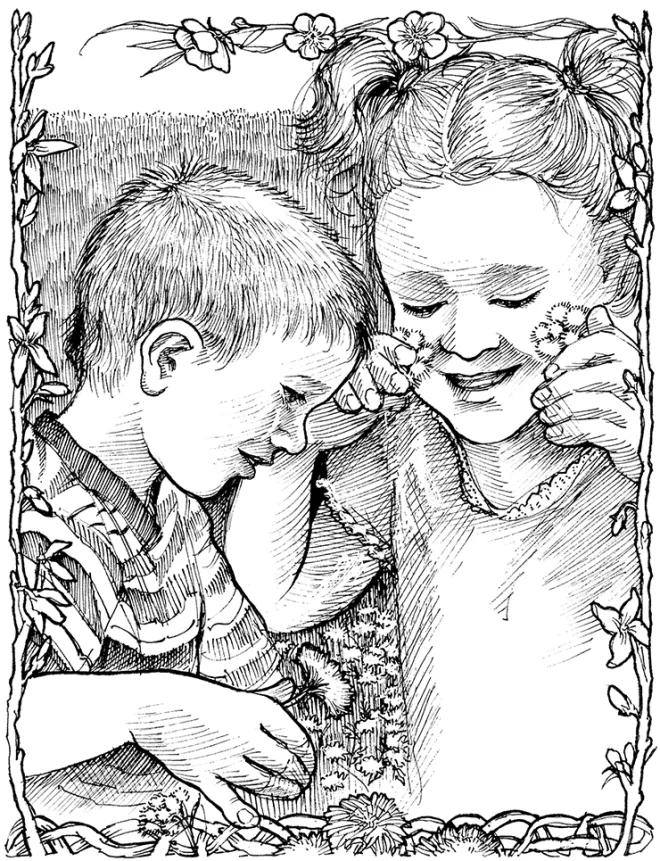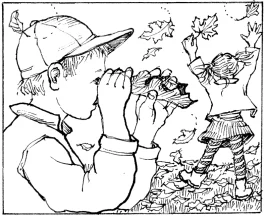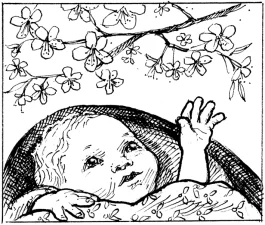
If you want to see a garden from a turn-your-world-upside-down perspective, take a small child with you for a walk through one. I discovered this truth while exploring with my grandchildren on various jaunts, through various seasons, in various gardens. Our grandkids are growing older now and have an eye for what a proper garden should look like. They know that firm, red tomatoes are the perfect ripeness for munching straight off the vine. They know how to spot the choicest blooms for making bouquets for the dinner table. They even know how to separate out and pluck broadleaf weeds from the lettuce beds. But when they were very little, they saw the world through a different lens, through what I call their “garden eyes.” They found magic in ordinary, close-to-the-ground things that we grown-ups trample underfoot. They chose treasures based on an inner esthetic only they understood.
A few years back, on an exquisite late Spring day, the kind that perfectly melds a warm sun with a dancing breeze which touches your skin like shade, I was babysitting then-toddlers, Kiera and Nate, aged 3 and 2 at the time.Unable to resist the day’s perfection, I took them out to the sloping front yard of their hilltop home to gather blossoms as a surprise for Mommy when she got home from work. The two toddlers opened my old eyes to a vista I’d forever seen but stopped noticing long ago. They passed right by the perfect tulips, with their heads bobbing red, yellow, peach, and pink. They shrugged dismissively at the cream-colored daffodils dipping their teacups in the wind. Instead, they headed straight for the swath of dandelions their Daddy tried so valiantly and vainly to mow into oblivion. Giggling with delight, they plucked fistfuls, being careful to choose only the lemony-maned tops—they had no interest in the rubbery stems. After dumping the blossoms into the basket I was toting, both kids turned their attention to the carpet of field pussytoes, rubbing the soft little fur balls over their cheeks before also dropping them into the basket—which now had kitty cats and lions, lolling together peacefully in a wicker bed on a sunny afternoon. Next they focused on the early buttercups and violets that dotted the landscape near the mailbox. Eventually they completed their harvest with bits of twigs, hair-like tufts of overgrown grass, and a few broken-off sprigs of forsythia to add a bit of flair.
Once we were back inside, it fell to me, their G-Myrt (The “G” is for Grandma; the Myrt, a nickname born decades ago from a barely amusing anecdote—you had to be there), to find a way to display the eclectic bouquet. A plastic juice cup worked well for the sticks and grasses, while a cereal bowl
During the brutal heat of late Summer, when a dry spell baked our veggie and flower gardens and shriveled even the daylilies, two other grandkids found a different kind of magic offered from beneath the soil. Earlier, while digging holes to plant the lilies, I had unearthed chunks of mica schist, tossing them about the garden because they added a touch of dazzle. When Lily and Joe were visiting, their attention was drawn to the micas with their gem-like luster highlighted in the fiery sunshine. Trying to think of something they could do, I suggested we go fossil hunting. We gathered some mica stones and took them to the shade of the back patio. Then we procured a couple of dull butter knives and some safety goggles, and set about prying apart the layers of silvery mineral rock. The kids were intrigued. Joe, who was only about three at the time, felt like Superman cracking apart solid stone. They both oohed and aahed at the swirly gray threads and sparkling squares of mirrored sheen in the exposed surfaces. Lily, at 9, wasn’t really buying the whole fossil thing, but she still enjoyed splitting the mineral rock into thinner and thinner slices and holding them up to the sun to create miniature rainbows in the refracted light. Joe, though, found fossils everywhere he looked—his imagination tracing birds and bugs in the squiggly lines arcing throughout the exposed facets. Lily, good big sister that she is, marveled over his finds. “Yes, that does look like an ancient earthworm, Joe. Good eyes!” Yes, good eyes. We spent over an hour playing archeologists in our tiny suburban backyard. Fancy glistens in the eyes of children if one just takes the time to look.

Fall brought more eye- and mind-opening experiences. Kiera and Nate wanted to gather leaves, so we set out through the grove of oaks, maples, and tulip poplars that circled their home. Racing down the dirt paths their Dad had hacked around the trees, they ignored the crimson, gold, and orange beauties that littered the ground. Instead, after brushing away the bright kaleidoscope of foliage, Nate gently scooped up one brittle, brown maple leaf, lying flat and stiff underneath. Next, he chose a rolled-up crispy tube of a dead oak leaf with some of its edges broken off. He carefully cradled the tattered thing, holding it up to one eye like a telescope, as he peered at something intriguing to him (but invisible to me). Kiera chose the hard to find, still-green maple leaves that fell before they trans-formed. Ordinary in the treetops throughout Spring and Summer, they were indeed a rare breed in the crimson and yellow carpet of the woodland floor. This was Fall splendor turned on its head, reminding me that every leaf is important no matter how plain. Are garden eyes also philosopher eyes?

Winter brought a remembered Summer diversion for Joe. One day, when he was out running errands with his Dad, the two stopped by. Joe bounced up the driveway and shouted, “Hey G-Myrt! You got any more fossil rocks?” Fortunately, I had a small pile on hand. Once goggled and equipped, he dug in, a now practiced expert, proudly showing his Dad how to unlock the treasures buried between the layers. Dad smiled, and I watched as my grown son’s own mind wandered back through time, borne by his little boy’s garden eyes, to a place where he could once again behold forgotten marvels.
Fast forward a few years, and a new grandchild opens her eyes to the world of nature. As I pushed little Sophia in her stroller on a Spring morning when the bright air breathed the joy of new life into us, I saw the newly awakened glimmer of magic in her sky-blue eyes. Nestled deep in the swaddling curves of her stroller seat, her view was restricted to what floated above her as we ambled along. But that was enough. A frisky breeze ruffled through ribbony branches of flowering cherry trees, swaying pink and white. Sophia stared wide-eyed at the madcap choreography above her. As we passed tree after swooshing tree, her little eyes darted to and fro. She smiled a bit, but mostly her face held an expression of serious study as she puzzled things out with a set of newly opening garden eyes.
What draws these little ones to sights we seasoned gardeners view as familiar or mundane? I never ask. I just smile with awe and a bit of envy, never wanting to spoil the enchantment by making them question their choices. Let the children savor their secret kingdom; it will fade too soon. In those moments of shared experience, I am the interloper, allowed, for just a fleeting moment, to see through their garden eyes and revive my own, long-sleeping inner child. ❖


 Previous
Previous

